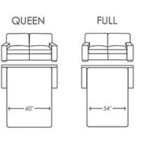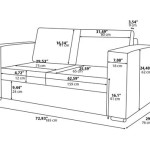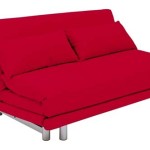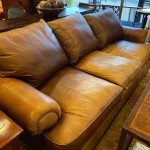How Wide Is A 2 Seater Sofa? A Comprehensive Guide
Determining the precise width of a 2-seater sofa can be more complex than simply assuming a standard measurement. While the term "2-seater" implies the sofa is designed to comfortably accommodate two individuals, the actual dimensions can vary significantly depending on several factors including the design style, armrest thickness, and overall aesthetic of the piece. Understanding these factors is crucial for making informed decisions when purchasing furniture, ensuring that it fits appropriately within the intended space and meets the specific needs of the occupants.
The width of a 2-seater sofa is a critical measurement for space planning. Before purchasing any furniture, measuring the area where the sofa will reside is essential. Consider not only the length and width of the space but also the accessibility and flow of traffic around the furniture. A sofa that is too wide can obstruct pathways, making the room feel cramped and uncomfortable. Conversely, a sofa that is too narrow might appear disproportionate and fail to provide adequate seating. Therefore, a thorough understanding of typical width ranges and the factors that influence them is vital.
This article will delve into the various aspects that contribute to the overall width of a 2-seater sofa, providing a comprehensive guide to help consumers navigate the furniture market with confidence. We will explore the range of typical dimensions, analyze the influence of design styles, and discuss the importance of careful measurement and consideration of individual needs.
Understanding Typical Width Ranges for 2-Seater Sofas
Generally, a 2-seater sofa falls within the width range of 58 inches to 78 inches (approximately 147 cm to 198 cm). This range is quite broad, highlighting the diversity of designs available. The specific width within this range will depend on several factors, including the manufacturer, the design aesthetics, and the intended seating arrangement. It is important to acknowledge that these dimensions are considered *external* measurements, taking into account the arms and any decorative elements that contribute to the overall width of the piece.
Smaller 2-seater sofas, typically measuring closer to the 58-68 inch range, are often designed for apartments, smaller living rooms, or as secondary seating options in larger spaces. These sofas often prioritize space efficiency and may feature narrower armrests or streamlined designs. They aim to provide comfortable seating for two without overwhelming the room.
Larger 2-seater sofas, extending towards the 70-78 inch range, often offer a more luxurious seating experience. They may feature wider armrests, deeper seats, and more substantial cushioning. These larger models can provide a more comfortable and relaxed seating arrangement, potentially allowing two individuals to lounge comfortably or even accommodate a third person in a pinch. However, they also require more space and may not be suitable for smaller living areas.
It is crucial to consult the manufacturer's specifications for accurate measurements. Before purchasing a sofa online or in-store, always verify the dimensions provided. Do not rely solely on the "2-seater" designation, as this can be misleading. Examine the product description carefully or contact the retailer to confirm the width, depth, and height of the sofa. Keep in mind that slight variations in measurements may occur due to manufacturing tolerances, so allow for a small margin of error when planning your space.
Furthermore, consider the internal seating width, which is the actual space available for occupants to sit. This may be less than the overall width of the sofa due to the thickness of the armrests and the internal structure. If seating capacity is a primary concern, focus on the internal seating width to ensure that the sofa provides adequate space for two individuals to sit comfortably side-by-side.
The Influence of Design Styles on Sofa Width
The design style of a 2-seater sofa significantly impacts its overall width. Different design aesthetics prioritize different features and dimensions, leading to variations in the size and shape of the sofa. Understanding how specific design styles influence width can help consumers choose a sofa that complements their existing décor and meets their space constraints.
Mid-century modern sofas, for example, often feature clean lines, tapered legs, and a minimalist aesthetic. These sofas tend to have narrower armrests and a more compact design, resulting in a width closer to the lower end of the typical range (58-68 inches). The emphasis is on functionality and a streamlined appearance, making them ideal for smaller spaces or contemporary interiors.
Traditional sofas, on the other hand, typically exhibit more ornate detailing, rolled armrests, and plush cushioning. These sofas often have wider armrests and a more substantial frame, contributing to a greater overall width (68-78 inches). The emphasis is on comfort and a classic aesthetic, making them suitable for larger living rooms or more formal settings.
Contemporary sofas encompass a wide range of designs, from sleek and minimalist to bold and sculptural. The width of a contemporary sofa can vary significantly depending on the specific design elements. Some contemporary sofas may prioritize space efficiency with narrow armrests and a compact frame, while others may feature oversized cushions and a more relaxed silhouette, leading to a wider overall dimension.
Sectional sofas, even those configured as a 2-seater, can also vary in width. Sectional pieces often have wider arms or connecting elements that expand the overall width. The modular nature of sectionals allows for customization, which can further influence the overall dimensions.
Furthermore, the material used in the construction of the sofa can also play a role. For instance, sofas with wooden frames and exposed legs may have a smaller footprint compared to those with upholstered frames and concealed legs. The thickness of the upholstery and the type of filling material used in the cushions can also contribute to the overall width.
Measuring Considerations and Individual Needs
Accurate measurement is paramount when selecting a 2-seater sofa. Simply estimating the available space is insufficient; precise measurements are necessary to ensure that the sofa fits comfortably and does not obstruct pathways or interfere with other furniture. This process involves measuring not only the intended location for the sofa but also the doorways and hallways through which it must pass during delivery.
Before measuring, clear the area where the sofa will be placed. Remove any existing furniture or obstacles that might impede accurate measurements. Use a reliable measuring tape and ensure that it is held taut and straight. Measure the width, depth, and height of the space, accounting for any architectural features such as baseboards or moldings.
Consider the flow of traffic around the sofa. Ensure that there is sufficient space for people to walk comfortably without squeezing past the furniture. A general rule of thumb is to allow at least 30 inches of clearance between the sofa and other furniture or walls. This will provide adequate space for movement and prevent the room from feeling cramped.
When measuring doorways and hallways, pay attention to the narrowest points. Measure the width of the doorway opening and the height of the ceiling. Also, measure the diagonal distance from the top corner of the doorway to the opposite bottom corner. This will help determine whether the sofa can be maneuvered through the doorway without difficulty.
Beyond space considerations, understanding individual needs is crucial. Consider the height and build of the individuals who will be using the sofa. Taller individuals may require a deeper seat depth for comfortable seating, while those with mobility issues may benefit from a higher seat height. The firmness of the cushions and the presence of lumbar support can also influence comfort levels.
If small children or pets will be using the sofa, consider the durability and cleanability of the upholstery. Fabrics such as microfiber or leather are often more resistant to stains and scratches than delicate materials like velvet or linen. Choosing a sofa with removable and washable cushion covers can also simplify maintenance.
Finally, consider the overall style and aesthetic of the room. Choose a sofa that complements the existing décor and enhances the overall ambiance. Consider the color, texture, and pattern of the upholstery, and ensure that it harmonizes with the other furniture and accessories in the room.
By carefully considering these factors, consumers can make informed decisions when purchasing a 2-seater sofa, ensuring that it fits appropriately within the intended space, meets the specific needs of the occupants, and enhances the overall aesthetic of the home.

Luna 2 Seater Sofa Water Repellent Fabric Bedandbasics

Byron Grey Fabric 2 Seater Sofa Furniturein

Luxe 2 Seater Sofa Homebird Furniture

Buy Flora Beige And Dark Brown Colour Two Seater Sofa At Best

Nill Astonic 2 Seater Fabric Sofa Beige Furniture

John Lewis Camden Medium 2 Seater Sofa

Heal S Matera 2 Seater Sofa

Buy Simpson 2 Seater Fabric Sofa In Uae Homebox

Hepburn Shabby Chic Vintage Leather Small 2 Seater Sofa

John Lewis Bailey Medium 2 Seater Sofa
Related Posts








